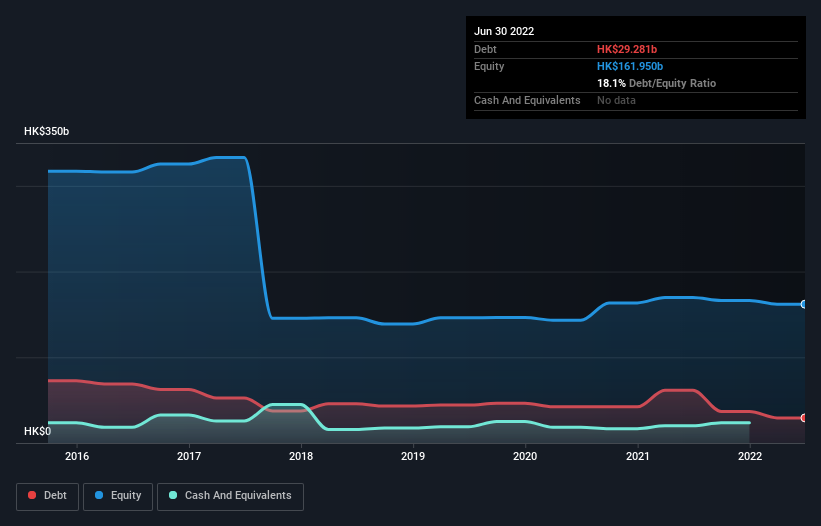
Warren Buffett famously said, 'Volatility is far from synonymous with risk.' When we think about how risky a company is, we always like to look at its use of debt, since debt overload can lead to ruin. As with many other companies Wharf (Holdings) Limited (HKG:4) makes use of debt. But is this debt a concern to shareholders?
Why Does Debt Bring Risk?
Debt is a tool to help businesses grow, but if a business is incapable of paying off its lenders, then it exists at their mercy. If things get really bad, the lenders can take control of the business. However, a more common (but still painful) scenario is that it has to raise new equity capital at a low price, thus permanently diluting shareholders. By replacing dilution, though, debt can be an extremely good tool for businesses that need capital to invest in growth at high rates of return. The first step when considering a company's debt levels is to consider its cash and debt together.
See our latest analysis for Wharf (Holdings)
What Is Wharf (Holdings)'s Debt?
The image below, which you can click on for greater detail, shows that Wharf (Holdings) had debt of HK$29.3b at the end of June 2022, a reduction from HK$61.6b over a year. However, because it has a cash reserve of HK$23.6b, its net debt is less, at about HK$5.72b.

How Healthy Is Wharf (Holdings)'s Balance Sheet?
According to the last reported balance sheet, Wharf (Holdings) had liabilities of HK$38.8b due within 12 months, and liabilities of HK$41.9b due beyond 12 months. Offsetting this, it had HK$23.6b in cash and HK$2.44b in receivables that were due within 12 months. So it has liabilities totalling HK$54.7b more than its cash and near-term receivables, combined.
This is a mountain of leverage even relative to its gargantuan market capitalization of HK$89.1b. Should its lenders demand that it shore up the balance sheet, shareholders would likely face severe dilution.
We measure a company's debt load relative to its earnings power by looking at its net debt divided by its earnings before interest, tax, depreciation, and amortization (EBITDA) and by calculating how easily its earnings before interest and tax (EBIT) cover its interest expense (interest cover). This way, we consider both the absolute quantum of the debt, as well as the interest rates paid on it.
Wharf (Holdings) has a low net debt to EBITDA ratio of only 0.68. And its EBIT covers its interest expense a whopping 58.0 times over. So we're pretty relaxed about its super-conservative use of debt. The modesty of its debt load may become crucial for Wharf (Holdings) if management cannot prevent a repeat of the 40% cut to EBIT over the last year. When a company sees its earnings tank, it can sometimes find its relationships with its lenders turn sour. There's no doubt that we learn most about debt from the balance sheet. But it is future earnings, more than anything, that will determine Wharf (Holdings)'s ability to maintain a healthy balance sheet going forward. So if you're focused on the future you can check out this free report showing analyst profit forecasts.
Finally, a business needs free cash flow to pay off debt; accounting profits just don't cut it. So we always check how much of that EBIT is translated into free cash flow. Looking at the most recent three years, Wharf (Holdings) recorded free cash flow of 39% of its EBIT, which is weaker than we'd expect. That's not great, when it comes to paying down debt.
Our View
Neither Wharf (Holdings)'s ability to grow its EBIT nor its level of total liabilities gave us confidence in its ability to take on more debt. But the good news is it seems to be able to cover its interest expense with its EBIT with ease. Taking the abovementioned factors together we do think Wharf (Holdings)'s debt poses some risks to the business. So while that leverage does boost returns on equity, we wouldn't really want to see it increase from here. In light of our reservations about the company's balance sheet, it seems sensible to check if insiders have been selling shares recently.
If you're interested in investing in businesses that can grow profits without the burden of debt, then check out this free list of growing businesses that have net cash on the balance sheet.
Valuation is complex, but we're here to simplify it.
Discover if Wharf (Holdings) might be undervalued or overvalued with our detailed analysis, featuring fair value estimates, potential risks, dividends, insider trades, and its financial condition.
Access Free AnalysisHave feedback on this article? Concerned about the content? Get in touch with us directly. Alternatively, email editorial-team (at) simplywallst.com.
This article by Simply Wall St is general in nature. We provide commentary based on historical data and analyst forecasts only using an unbiased methodology and our articles are not intended to be financial advice. It does not constitute a recommendation to buy or sell any stock, and does not take account of your objectives, or your financial situation. We aim to bring you long-term focused analysis driven by fundamental data. Note that our analysis may not factor in the latest price-sensitive company announcements or qualitative material. Simply Wall St has no position in any stocks mentioned.
About SEHK:4
Wharf (Holdings)
Founded in 1886 as the 17th company registered in Hong Kong, The Wharf (Holdings) Limited (Stock Code: 0004) is a premier company with strong connection to the history of Hong Kong.
Excellent balance sheet with moderate growth potential.


